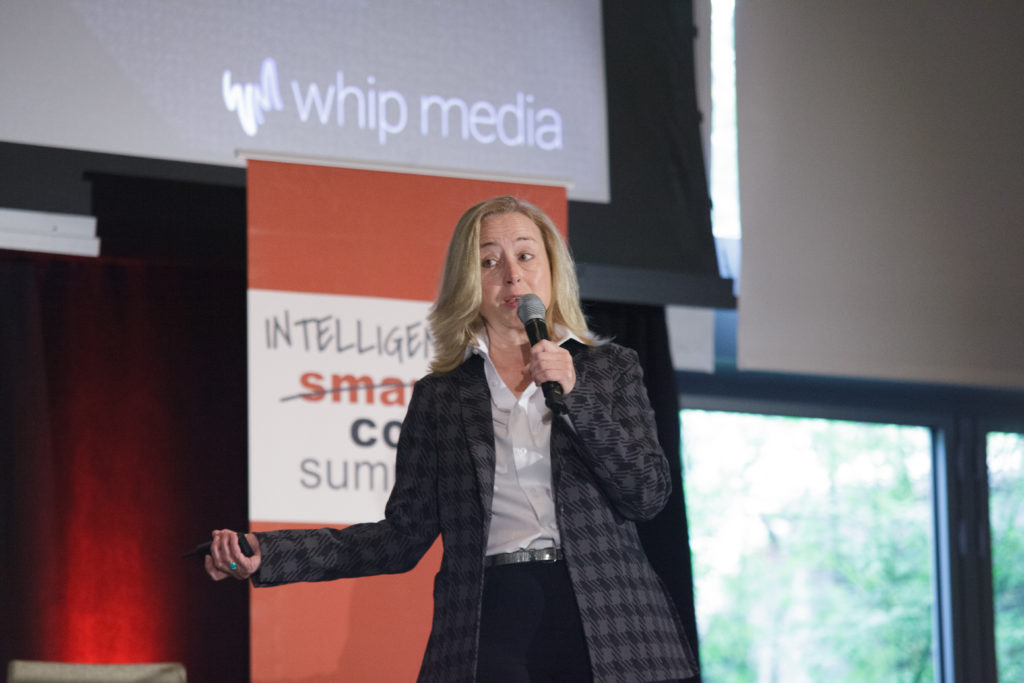
Smart Content Summit: The Power to Predict Content Performance
The high-volume, high-velocity global content environment we are in now has challenged the way media and entertainment (M&E) organizations buy and sell content, according to Whip Media.
As M&E companies play catch-up with the growth of streaming services, it has become crucial for operators and distributors to find smarter, more efficient ways to improve the current process of content licensing and planning and make better decisions.
New tools and technology from companies including Whip Media that are able to ignite the right connections between content buyers and sellers, using a data-driven approach and predictive insights, are helping M&E companies accelerate their dealmaking and maximize revenues, according to Sherry Brennan, EVP and GM-Whip Media Exchange at Whip Media.
“As I don’t really probably need to tell anybody in the room, there is just a huge tipping point we’ve crossed over in the last couple of years, with respect to the volume of content, the number of platforms around the world [and] where content’s being distributed,” she said March 10 at the Smart Content Summit in Los Angeles, during the session “Smart Licensing: The Power to Predict Content Performance.”
“It’s a problem that we know of really personally as consumers, like we all forget where do we go to watch what show or movie, what episode am I am on, what season am I on – things like that,” she pointed out.
 “Just as it’s a problem for consumers, it is a real challenge for content owners and for platforms and buyers of content rights – just to keep it all straight [with] all these new business models proliferating,” she noted.
“Just as it’s a problem for consumers, it is a real challenge for content owners and for platforms and buyers of content rights – just to keep it all straight [with] all these new business models proliferating,” she noted.
Additionally, as a result of globalization, content companies need to have metadata in different languages, she said.
“If you’ve got a platform like ours, eventually we’re going to have to have training and instruction in different languages,” she told attendees and those viewing the session online. “All that makes the whole problem more complicated,” she said. But it also represents an “opportunity,” she pointed out.
Intelligence and automation are needed in this new world but “we’re still using our gut instinct in some cases,” she noted.
Whip Media, on the other hand, is bringing science into the conversation to help M&E companies make better decisions, she added.
The Whip Media Exchange
On May 25, Whip Media unveiled its artificial intelligence-powered content marketplace Exchange, connecting buyers and sellers using one centralized platform, streamlining the process of buying, selling and discovering content.
The company built the Whip Media Exchange to overcome the emergence of streaming vastly complicating content licensing, according to the company. Associated challenges today include the exponential increase seen in types of rights (including AVOD, SVOD and linear), the proliferation of new platforms globally and the vastly increased content demand we have seen and capacity per platform, Whip Media says.
The Exchange helps organizations: learn which content is expected to perform better; understand viewer demand through deep insights into preference, behavior, engagement and more; easily connect with partners around the world; adapt rapidly as the environment and business models change; manage complex workflows; and gain visibility across hundreds of thousands of titles and hundreds of platforms globally, according to the company.
M&E organizations can use Whip Media’s Demand Score to evaluate content for new audiences, such as by predicting performance for a territory where the company hasn’t operated before, it says. Titles can be ranked by their predicted performance. Organizations can select those titles expected to perform best in a specific region. They can also identify available content with high Demand Scores that meet other criteria, including age/gender, content genre and the platform or regional fit/appeal.
TV Time
Whip Media, meanwhile, also has its TV Time global app that helps bring understanding to changing consumer behaviors.
The app now has over 20 million users, most of them outside the U.S., Brennan said. TV Time, meanwhile, offers over 22 billion TV and movie insights from those 20 million users
There are about 400,000 titles in its database, Brennan noted, adding that the app can “harvest a ton of information.”
The app creates algorithms that indicate what viewers are likely to watch from platform and territory.

More to Come
Whip Media, meanwhile, plans to add “additional factors” to provide even greater context, Brennan said, calling that plan “a work in progress.”
Those other factors, including similar metadata, performance of similar titles, cultural compatibility and territorial fit drive Demand Scores up or down, according to the company. Understanding the Demand Score factors lends context to each title.
During the Q&A, Brennan said: “We have not partnered with a recommendation engine although we have talked to a lot of them” and “I would love to have their data added to our dataset and see what it would add to the mix; I think it would be very interesting.”
The 2022 Smart Content Summit event was held in conjunction with the EIDR Annual Participant Meeting (EIDR APM), and was presented by Whip Media. The event was produced by MESA, in association with the Smart Content Council and EIDR, with sponsorship by BeBanjo, Signiant, Qumulo, Adio, Alteon, Digital Nirvana, Slalom and Rightsline.
